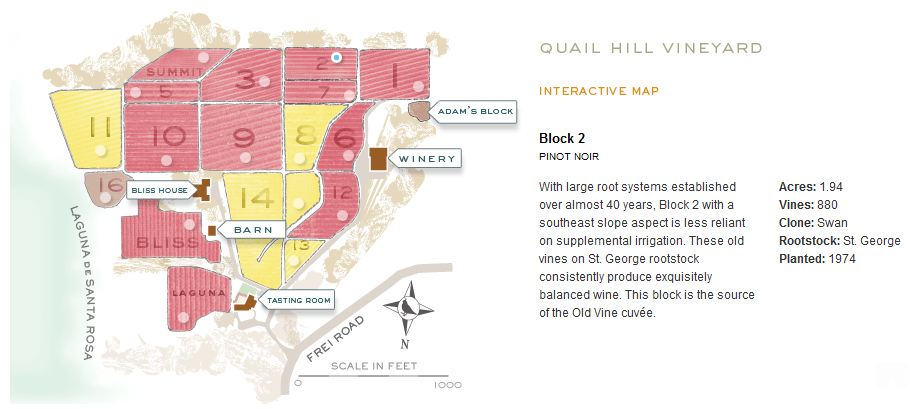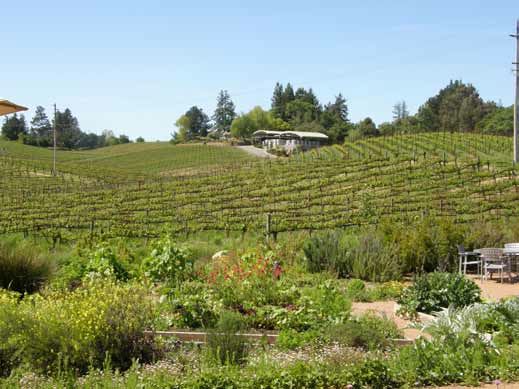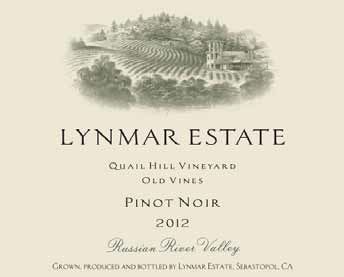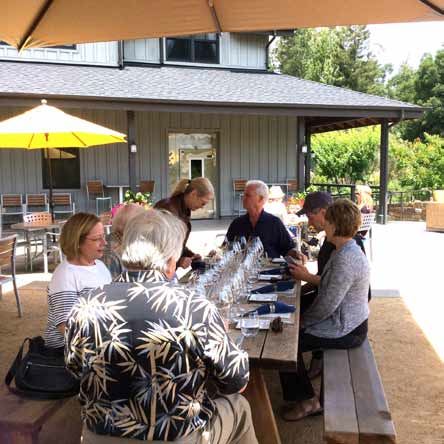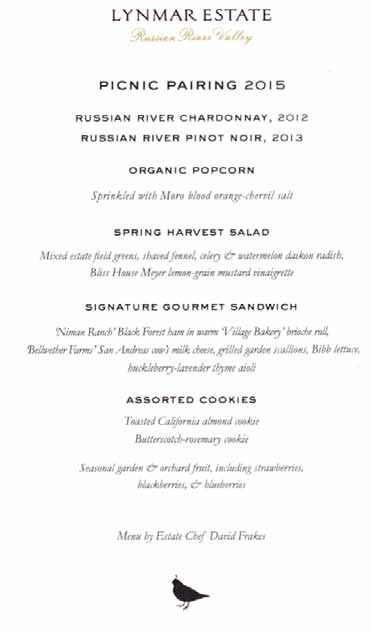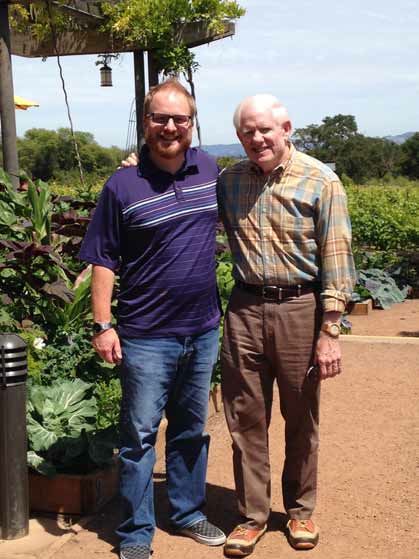Lynmar Estate Quail Hill Vineyard
The Quail Hill Estate Vineyard Block 2 was first planted in 1974 (the Lynmar website says 1971 but the
winery’s vineyard manager, Jason Sailing, told me that he confirmed with Tom Dehlinger who assisted in the
acquisition of the cuttings that it was 1974) and has some of the oldest Pinot Noir vines in the Russian River
Valley. These vines are some of the first established in the Russian River Valley with budwood from Joe Swan
and is the only remaining block from the original plantings. A phased replanting involving 71% of the vineyard
was undertaken in 1996, but select heritage blocks including the 2+ acres of Swan selection Pinot Noir planted
in 1974 were retained. An additional 1.2 acres of Swan selection was planted in 1997 as Block 12, using
budwood sourced directly from the original vines. The grapes from these original vines were sold to Tony Soter
and Merry Edwards, until Lynmar began its own winemaking activity in the early 1990s.
The Swan selection vines are in Block 2 and in Block 12 as shown in the map below. The photo shows the
winery in the distance with Block 2 in the far distance and Block 12 in front of the winery.
The Swan selection grapes have been a part of Lynmar’s Quail Hill Cuvée and Quail Hill Vineyard wines but
were bottled separately as an Old Vines Pinot Noir for the first time in 2009. The 2012 Quail Hill Vineyard Old
Vines Pinot Noir was a glorious wine when tasted in barrel and later in bottle in July 2014, and given a score of
95 (one of my 2014 All-American Pinot Noirs). The wine is currently sold out but a magnum is available ($185).
The legendary Joseph (Joe) Swan first planted Pinot Noir, along with Chardonnay and Cabernet Sauvignon,
beginning in 1969, replacing a 13-acre plot of Zinfandel on Laguna Road in the Santa Rosa Plain area of the
Russian River Valley that he acquired in 1967. It was Joe’s friend, Andre Tchelistcheff who advised him to plant
Burgundy varieties on this site.
According to current J. Swan proprietor and winemaker, Rod Berglund, the budwood for the original Pinot Noir
plantings probably came from Martin Ray’s vineyard (now Mount Eden) in the Santa Cruz Mountains, originally
brought into this country from France by Paul Masson. The budwood was obtained from the Experimental
Station in Oakville. Some nursery selections were also planted but later abandoned. Joe marked the most
redeeming vines in his vineyard and grafted the nursery selection roots over from wood he deemed to be the
best. There were also DRC “suitcase” selections planted that were given to Joe as a gift by an unnamed
individual many years ago (exact dates unknown). The resulting vine mix was later named the “Swan clone” by
Francis Mahoney, the founder of Carneros Creek Winery. An additional block of Pinot Noir was planted just
south of the original planting in 1974.
Joe produced some very good and age worthy Pinot Noirs from his vines and helped to establish the credibility
of Russian River Valley Pinot Noir. A Pinot Noir from the Swan vineyard, now called the Trenton Estate, was
sourced entirely from the original 1969 and 1974 plantings from 1973 to 2002 (after 2002, some young vine
fruit was added). The designation, “Trenton Estate,” did not appear until 1997. Cuttings from Swan’s vines were
eagerly sought after, and because of Joe’s generosity, became widely distributed to other California vineyards
as the Swan clone or Swan selection.
Lynmar has one of the most spectacular hospitality centers in Sonoma County with tasting available in both an
indoor and expansive outdoor venue. The photo below shows our happy group basking in the sunshine and
seated for a Picnic Pairing 2015 lunch at Lynmar Estate (menu is reproduced below). Lynmar Estate has a full
time chef and various food options are offered in the tasting venue.
Lunch wines:
2012 Lynmar Estate Russian River Valley Chardonnay
14.2% alc., 843 cases, $35. A blend of Quail Hill
Estaate and Sweeney Vineyard with a small amount of Zio Tony Vineyard. Aged 15 months in 32% new French
oak barrels. Previously reviewed July 19, 2014.
·
Light gold color in the glass. Aromas of lemon curd,
butterscotch, pineapple, green apple, baked pear and spice are echoed on the silky palate. Easy to like, with
refreshing acidity, and complimentary oak highlights.
Score: 89
2011 Lynmar Estate Quail Hill Vineyard Russian River Valley Chardonnay
14.1% alc., $55. Primarily Rued
clone.
·
Light golden yellow color in the glass. A step up from the solid Russian River Valley bottling with more
flesh, intensity and finish. Aromas of lemon oil and white peach lead to a very smooth palate of baked apple,
peach and pear fruits accented with honey and caramel.
Score: 91
2012 Lynmar Estate Quail Hill Vineyard Russian River Valley Pinot Noir
14.5% alc., 2,360 cases, $60. A
blend of 14 clones from the estate vineyard. Aged 10 months in 37% new French oak barrels. Previously
reviewed July 19, 2014.
·
Moderately dark reddish purple color in the glass. Deep aromas of fresh Bing cherry
and baking spice. Mid weight flavors of dark cherry, cola and sarsasparilla with a touch of oak in the
background. The tannins are suave and noble, and the finish is outfitted nicely with generous black cherry and
black raspberry fruits.
Score: 92
2013 Lynmar Estate Russian River Valley Pinot Noir
14.2% alc., 2,359 cases, $40. Sourced from six
vineyards including the Quail Hill Vineyard and Susanna’s Vineyard. Aged 10 months in 42% new French oak
barrels.
·
Moderately dark garnet color in the glass. Still young and a bit shy on the nose with scents of black
cherry and cake spices. Middleweight flavors of cherry pie glaze, strawberries, cola and spice are framed by
modest tannins.
Score: 89
Winemaker Shane Finley (formerly of Kosta Browne) stopped by to talk about Lynmar wines and offered a
taste of a few special bottles (see photo of Shane below). I must admit, I was having too many laughs and
enjoying Shane’s company too much to comment specifically on the wines he brought. Just say that he is
crafting a superb lineup of wines at Lynmar Estate, and if you visit, try to spend some time with him.



